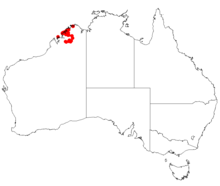Acacia adenogonia is a species of flowering plant in the family Fabaceae and is endemic to northern Western Australia. It is a prickly, erect to sprawling shrub with cylindrical branchlets, egg-shaped to lance-shaped phyllodes, flowers arranged in spherical heads of golden yellow flowers, and thin leathery pods that are constricted between the seeds.
| Acacia adenogonia | |
|---|---|
| Scientific classification | |
| Kingdom: | Plantae |
| Clade: | Tracheophytes |
| Clade: | Angiosperms |
| Clade: | Eudicots |
| Clade: | Rosids |
| Order: | Fabales |
| Family: | Fabaceae |
| Subfamily: | Caesalpinioideae |
| Clade: | Mimosoid clade |
| Genus: | Acacia |
| Species: | A. adenogonia
|
| Binomial name | |
| Acacia adenogonia | |

| |
| Occurrence data from AVH | |
| Synonyms[1] | |
| |
Description edit
Acacia adenogonia is a prickly, erect to sprawling shrub that typically grows to a height of 1–2.5 m (3 ft 3 in – 8 ft 2 in)[2] and has branchlets usually covered with white or greyish, downy hairs. Its phyllodes are more or less sessile, egg-shaped to lance-shaped, mostly 5–10 mm (0.20–0.39 in) long and 1.5–4.5 mm (0.059–0.177 in) wide, leathery and sharply pointed. There are tapering stipules up to 6.5 mm (0.26 in) long at the base of the phyllodes. The flowers are arranged in a spherical head 4–6 mm (0.16–0.24 in) in diameter, on a peduncle 7.5–14 mm (0.30–0.55 in) long. The head contains 60 to 92 golden-yellow flowers. Flowering has been observed in January, February and from May to September and the pod is thinly leathery, linear, 85 mm (3.3 in) long and 5–6.5 mm (0.20–0.26 in) wide, and constricted between the seeds. The seeds are elliptic, 6.0–6.5 mm (0.24–0.26 in) long and dull brownish-black with an aril on the end.[3][4][5]
Taxonomy edit
This species was first formally described in 1987 by Leslie Pedley who gave it the name Racosperma adenogonium in the journal Austrobaileya.[6][7] In 1990, Richard Sumner Cowan and Bruce Maslin transferred the species to Acacia as A. adenogonia in the journal Nuytsia.[8] The specific epithet (adenogonia) means "gland-angled".[9]
This species is included in the subgenus Phyllodineae.[10]
Distribution edit
Acacia adenogonia is native to an area in the Kimberley region of Western Australia.[2] The shrub has a scattered distribution with separate populations found through the West Kimberley particularly along the Bonaparte Archipelago, the Broome and Napier Bay areas, and inland as far as Phillips Range, Kimberley Downs Station and Beverley Springs Station, and is found on areas of sandstone growing in sandy soils as a part of woodland communities.[4]
See also edit
References edit
- ^ a b "Acacia adenogonia". Australian Plant Census. Retrieved 3 May 2024.
- ^ a b "Acacia adenogonia". FloraBase. Western Australian Government Department of Biodiversity, Conservation and Attractions.
- ^ Cowan, Richard S.; Kodela, Phillip G. "Acacia adenogonia". Flora of Australia. Australian Biological Resources Study, Department of Climate Change, Energy, the Environment and Water: Canberra. Retrieved 3 May 2024.
- ^ a b "Acacia adenogonia". World Wide Wattle. Western Australian Herbarium. Retrieved 20 September 2020.
- ^ Cowan, Richard S.; Maslin, Bruce R. (1990). "Acacia Miscellany 2. Species related to A. deltoidea (Leguminosae: Mimosoideae: Section Plurinerves) from Western Australia". Nuytsia. 7 (2): 203–204. Retrieved 3 May 2024.
- ^ "Racosperma adenogonium". APNI. Retrieved 3 May 2024.
- ^ Pedley, Leslie (1987). "Racosperma deltoideum (Cunn. ex G.Don) Pedley (Leguminosae: Mimosoideae) and related species in northern Australia". Austrobaileya. 2 (4): 315. Retrieved 3 May 2024.
- ^ "Acacia adenogonia". APNI. Retrieved 3 May 2024.
- ^ Sharr, Francis Aubi; George, Alex (2019). Western Australian Plant Names and Their Meanings (3rd ed.). Kardinya, WA: Four Gables Press. p. 127. ISBN 9780958034180.
- ^ "Acacia adenogonia". World Wide Wattle. Retrieved 3 May 2024.